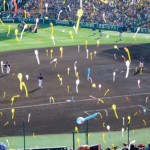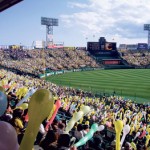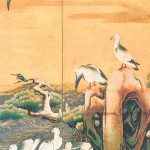Of Bows, Brews, Baseball, Balloons
KYOTO – The Land of the Rising Sun is also The Land of Many Bows. So I was reminded on a recent trip to Japan, my third in three years (a string I hope to continue next year).
People bow to one another all the time – the formal from-the-waist bow, such as you receive from restaurant or hotel staff, or a more casual, in-passing dip of the shoulders and head, such as when acquaintances and even strangers pass.
On trains, as the blue-uniformed ticket checker exits each car, he turns and bows to passengers. So too do young women pushing snack/beverage carts.
- Hanshin Tigers fans with balloons and letting them fly at Koshien Stadium in Osaka
- Hanshin Tigers fans with balloons and letting them fly at Koshien Stadium in Osaka
- A small portion of Sansetsu’s ‘Waterfowl on a Snowy Shore’
This trip included an amateur baseball game in the southern Tokyo suburb of Fussa, where at the end of a 3-0 win the host Nishitama club team and its Tokyo foes lined up facing each other. The two captains stepped forward and bowed, then stepped back, and both teams bowed.
Afterward, Nishitama coach Masato Kagawa, the former Wasada University and Kintetsu Buffaloes star pitcher, conducted a crisp, lively infield-outfield practice. As each player sprinted off the field, instead of returning to the dugout as in the U.S., they lined up along the first base line. When the last player joined them, they bowed in unison to their coach.
Later in Kyoto, as I passed a grandmother walking a boy about 2 years old, she said to him, “Bow to him,” and demonstrated. The toddler did a little bow, which I returned in my ungainly gaijin way. Yes, it starts early and is well ingrained.
The bow is more than just politeness. It is a sign of respect for others, and of personal humility, but also says, “I recognize you and your right to be on this Earth and in this space we share.” It is a sign of peace.
It is one of my favorite things about Japan.
OK, I have many favorite things about Japan, including food and beverage. After that baseball game in Fussa, Masato Kagawa introduced me to a traditional sake maker, Ishikawa Brewery. They brew a variety of sakes, the freshest I have ever tasted. The cold daiginjo went delightfully with fare in the brewery restaurant that was both modern and traditional. Yes, I did bring a couple of bottles home.
Also brought home sencha green tea from the Ippodo shop in Kyoto. The company makes a variety of teas, and goes back to 1717.
It’s almost impossible to have a bad meal in Japan because so much attention is paid to details, whether at the brewery, a katsu restaurant in Tachikawa, a sushi restaurant in Shinjuku or the restaurant at 1,100-year-old Daigoji temple in Kyoto, where the cold soba noodles had a slightly pinkish hue – from being boiled with cherry blossoms.
Baseball is another favorite. Over lunch in Fussa, Masato had a great story about facing international home run king Sadaharu Oh the first time. Nervously thinking, “He’s the king,” the young pitcher promptly served up a home run – which, as I noted, puts him in good company with a lot of other hurlers as Oh-san smacked 867 other homers (including five in one game). But the next two times up, he struck out and popped out. By the way, post-game practice for his club team is not standard for all teams in Japan, but Masato insists on the extra work. It’s one reason he’s sent several of his Nishitama players to the Japanese big leagues in recent seasons.
The next day I attended a game in Osaka at historic Koshien Stadium, famous for infield dirt the color of dark-roast coffee (which high schoolers playing in the national tournament there scoop up to take home as a souvenir). It’s the home of the Hanshin Tigers, whose fans are the most happily enthusiastic in the world. The non-stop chanting and singing makes you think of European soccer, but this is more organized, with drumming and horns – and minus the hooligans. Each player has his own chant, which each of the 45,000 fans on a Sunday afternoon knew, and there are team songs. Everyone seemingly had bat-shaped “thunder-sticks” and tapped them rhythmically along with the drummers in the outfield.
The greatest was in the top of the seventh inning when almost everyone in the sold-out crowd blew up 3-foot-long Tigers balloons, and when the third out was made released them – quite a sight with 40,000-plus balloons shooting 20-30 feet in the air. Which they repeated after the Tigers won 5-0 over Yakult Swallows behind eight innings of two-hit, shutout pitching from 19-year-old sensation Shintaro Fujinami. (Remember that name.) At 50 cents a balloon, this is a very profitable tradition for Hanshin owners.
Another favorite is Japanese art. Last year I wrote about being mesmerized by the 600-year-old art of Sesshu, then on exhibit at the Suntory Museum in Tokyo. This time it was an exhibition of paintings by Kano Sanraku (1559-1635) and Sansetsu (1590-1651) at the Kyoto National Museum.
Their paintings were as huge as Sesshu’s, but to my eye more lyrical and certainly more colorful, with vibrant greens, reds, oranges and blues. Sanraku’s self-portrait is every bit as modern-looking as, say, Vincent Van Gogh’s (which was also in town for an exhibit at another museum).
In Sanraku’s “Plum Blossoms with Frolicking Birds,” the trunk and branches of a large tree seem to flow like a river. Yet in “The Old Plum” a tree rears up like a dragon. Towering waterfalls seem like architectural moldings. Beards seem like thatched roofing. And Sanraku’s renderings of buildings and bridges look like modern architectural drawings, line after perfectly parallel line.
Sansetsu added humor, such as in “Samurai Engaged in Sumo,” in which a smaller samurai throws a larger one through the air, leaving the larger man agape and onlookers laughing and pointing.
The finale, Sansetsu’s “Waterfowl on a Snowy Shore,” gave me chickenskin. It’s about 22 feet long, and this is the first time it has been seen in public exhibition. His depiction of ocean swells and waves is at once architecturally precise, but also alive with movement. The two men understood the sea, and so much more.
The exhibit closes May 12 and reopens in Boston next month.
I leave you now with a bow.






